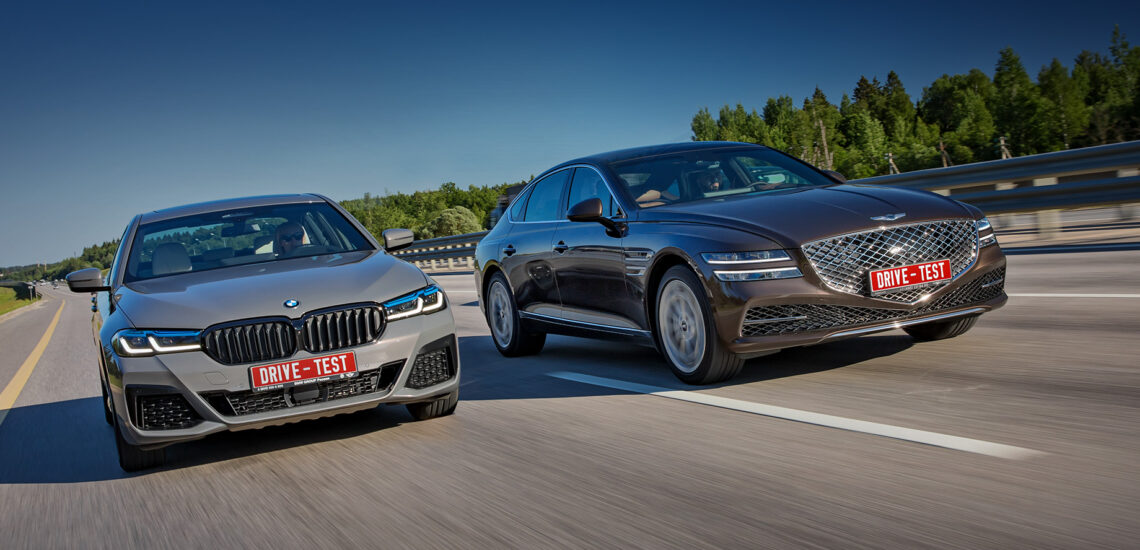In a comparative test with the Tuareg, the Genesis GV80 crossover didn’t perform well. Now we’re getting acquainted with the all-wheel drive Genesis G80, paired with almost the class leader — BMW 530d xDrive. The Korean sedan isn’t as high-status and expensive as the GV80 based on the same platform, and under the hood it has a trivial turbocharged engine. However, the G80 isn’t only turned out to be more pleasant than the related SUV on the go, but also looks very worthy against the background of the “five”.
The interior of the test “eighty” is solid. The puffed front panel is optionally trimmed with leather and decorated with a massive matte wood plank, under which there is a convenient touch-sensitive climate control unit. The pleasant metallic surface of the buttons, the pliant plastic in key areas, and the expensive smell add to the feeling of quality. But just like in the GV80, the column shift and steering wheel hub are made of cheap plastic.
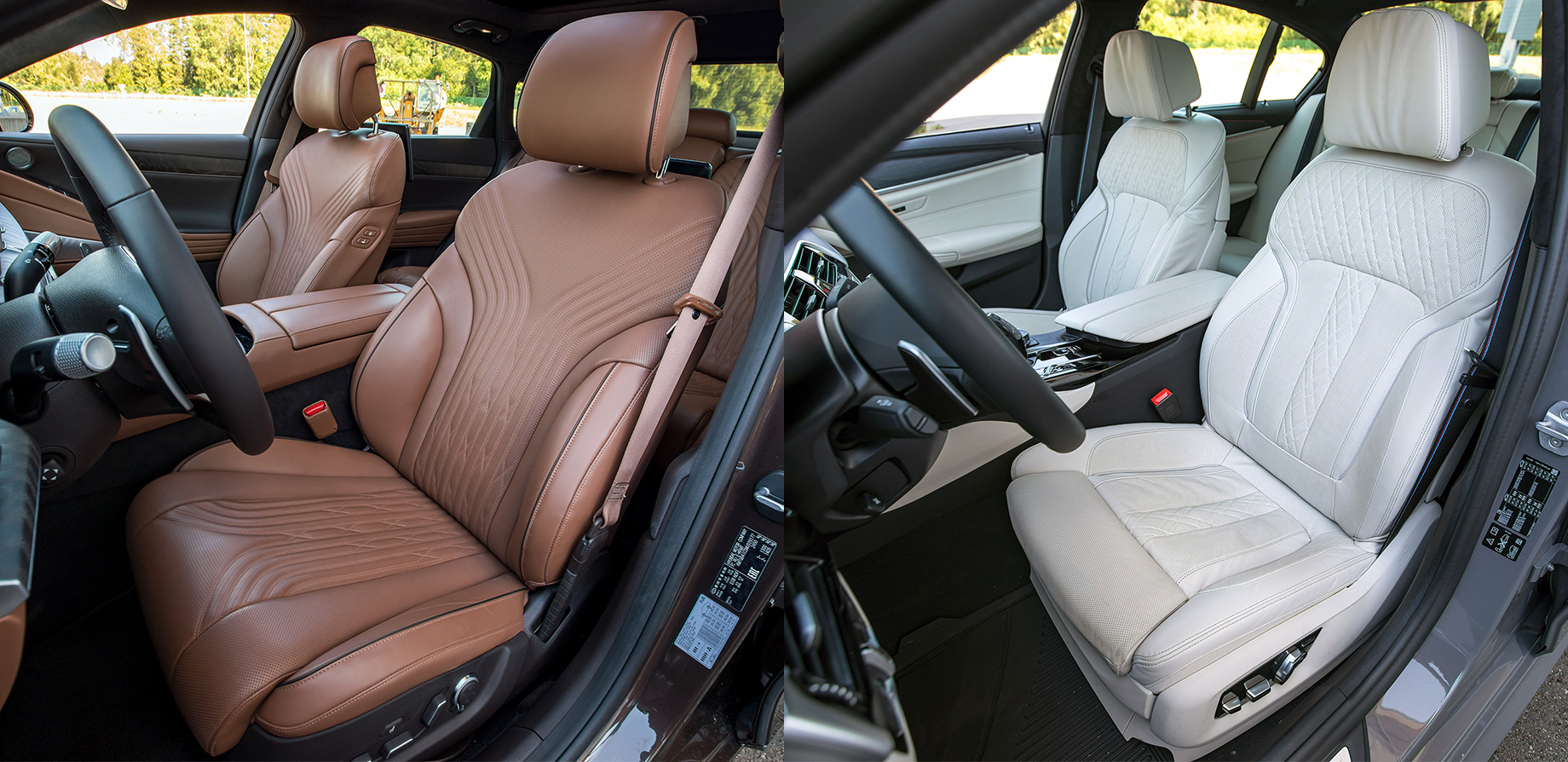
Ergonomic slips are familiar from the crossover. You need to reach the large touch screen with a high-quality picture, completely lifting your back from the chair. The rotary ring of the multimedia system with indistinct controls is more morally exhausting than helpful. Even though some business class passengers prefer the right front seat, the cushion extension, massager and adjustable side bolsters are reserved for the driver only. His seat, by the way, is more comfortable than at the same GV80, due to a less eminential back. Four spokes on the steering wheel are more convenient for me to use than two massive ones.
The trump of the Genesis is chic by the standards of the segment second row. Even without taking into account the electric drive, the backseat entices with soft padding and headrests, a soothing fit and a large supply of space in front of the knees. Under the barely audible buzz of the electric motor, the halves of the back row, independently of each other, are laid out almost into sleeping places. Just push the front right seat away from you and curtain the windows, and you can hardly keep your eyes open. In such an atmosphere, you instantly forget that there could have been more headroom, the interior could have been wider, and the floor tunnel could have been narrower and lower.
Discussing the second row of the “five” is awkward. The backseat does not move, the padding under the leather upholstery is dense, the landing geometry is strict, and there is half the space in front of the knees (although this is enough for people up to 6’06). Rear passengers have their own dual-zone climate control unit, heating, window blinds and padded headrests, but there is no magic. And it is no longer so important that the BMW interior is preferable in terms of width and space above the head, and the rear door openings are freer.
The “five” gets its own back with the driver’s seat — the best in the class! It’s as if you were poured into this seat — it fits the body so cool. Thicker padding than in the Genesis is already a plus. Not only the length of the cushion and the side bolsters are adjustable, but also the upper part of the back, which promises good shoulder support (which is lacking in the G80). BMW has more steering and front seat adjustment ranges, noticeably more headroom and the ability to sit down sportily.
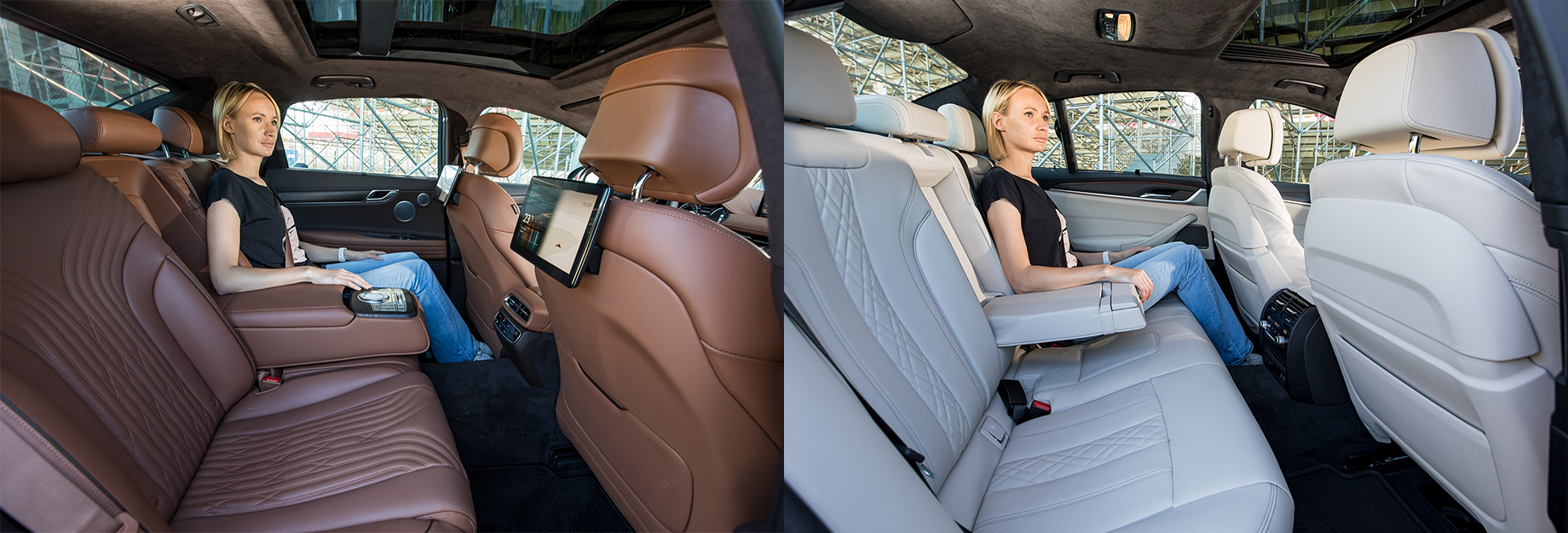
The BMW interior is not so pompous in appearance, but at least it is not inferior in terms of finish and build quality. A steering wheel with a plump M-rim is more comfortable, the display of the multimedia system is more contrasting and colorful, the font on it is larger and the touchscreen is located closer to the driver. It makes no sense to compare the convenience of controlling the multimedia system: it is a pleasure to use the BMW swivel shim and the hot keys around it.
However, everything is not so rosy. The virtual dashboard in the fifth series looks cheap, does not indulge in design variability and complicates reading information. BMW’s A-pillars are larger, which spoils visibility. The platform for wireless charging of smartphones and cup holders are poorly located relative to each other: occupying them, you block access to the gadget lying in a narrow niche.
On the go, the Genesis G80 is comfortable, especially acoustically. The Korean sedan outplays the diesel five-cylinder engine on wide Run Flat tires in one go. The G80 has a quieter motor that raises its voice only during kickdown, better soundproofing of wheel arches and doorways. Double-glazed windows not in the least make the G80 interior quiet. The BMW has single-layer side glazing.
The same goes for ride comfort. On the road without serious flaws, the Genesis gently and perfectly smooths the microprofile. It follows the course nobly and serenely. But the very first junction disconnects me from the Matrix and reveals the harsh reality. The adaptive suspension conveys bumps to passengers in the form of a solid hit, although the shock absorbers must preemptively adjust, receiving a hint from the cameras. As soon as the pits and potholes fly under the wheels in bursts, flabbiness of the chassis and a slight buildup of the body appear. Although the GV80 in such circumstances is even more pitiful.
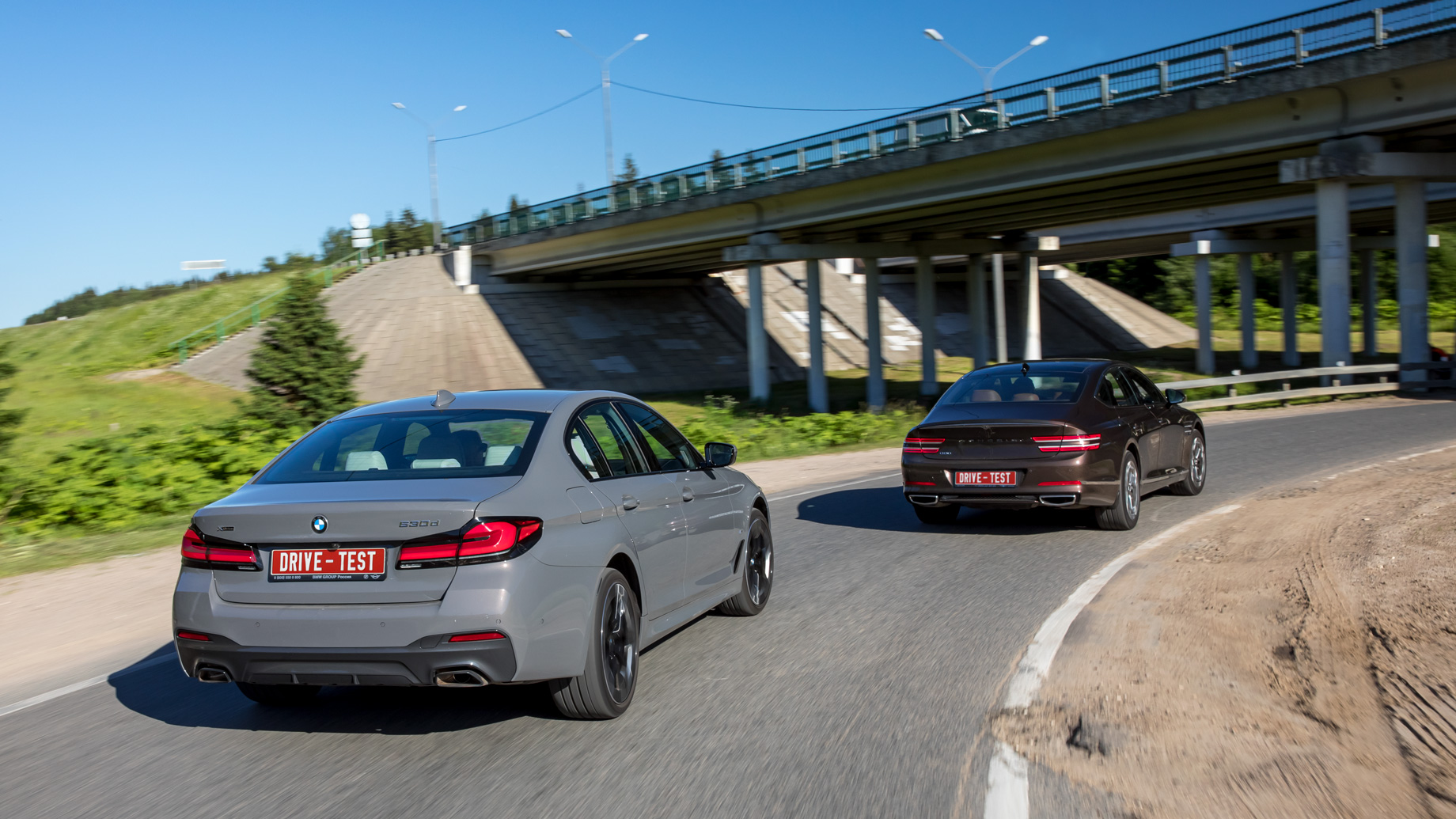
The 530d doesn’t twist around. The sport package, 20-inch wheels (the G80 has an inch less) and tires with reinforced sidewalls immediately hint that it won’t be soft. In any mode of electronically controlled shock absorbers, the sedan rides tightly, shaking passengers on medium and large road bumps. The microprofile of the road, which always hums, and shocks, when passing expansion joints, are more noticeable in the “five”. However, the breed is felt in a German car — the suspension does not allow itself to be lax under any circumstances.
As soon as the road starts to wind, the readiness of the “five” is already a plus. How vividly a large and heavy vehicle responds to commands! Reactions are fast and simple, rolls are minimal, and the steering wheel does not hide information. The suspension seems to grow into the body: the bones-like levers and joints are tightened by the muscles of a single organism. And when the impressive hold on the high-speed arc dries up, the sedan slides with four wheels. The brakes are also excellently tuned — they are tenacious, understandable, with a dosage of deceleration only by force.
However, the Genesis of his opponent slightly overbraked: after several attempts to stop from 62 miles/h, the G80 takes an average of 121,06 ft instead of 122.7 ft for BMW. But in regular situations, the “Korean” upsets with the mediocre calibration of the system: the pedal almost immediately stands stock-still, and you need to put pressure on it with great effort. It would be enough to discourage the desire to drive fast. The steering wheel without feedback, large rolls and laziness when changing direction are also unattractive. At the limit, the G80 just moves off the trajectory with its beautiful front end.
It is incorrect to compare the dynamics, but no one bothers us to evaluate the operation of the motors individually. The G80 has a gasoline supercharged four-cylinder engine, BMW is driven by an in-line six-cylinder turbodiesel. The engine of 2.5 liter is vigorous on paper (249 hp, 422 N•m) and provides good elasticity, but its limiting capabilities are only enough for the prescribed program. The character of the thrust is even, the responses to the fuel supply are soft even in sport mode, the engine does not bother passengers with a sound.
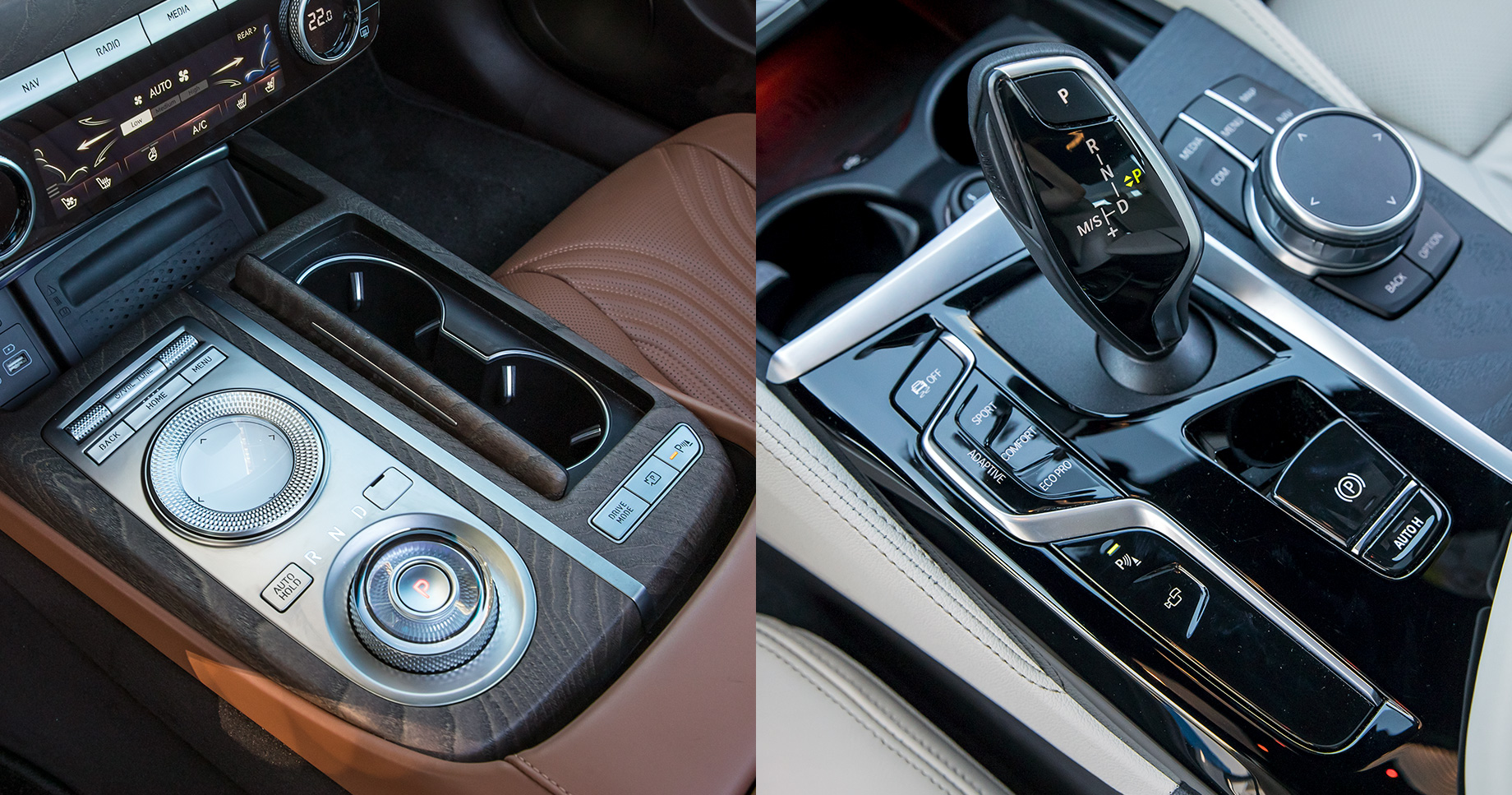
With rapid acceleration from a standstill, the “Korean” lingers at the beginning of the start, and Racelogic fixes the first 62 miles/h in 7.1 seconds instead of the declared 6.5. Up to 74-80 miles/h, the speed grows briskly, and after the dynamics noticeably sags. In general, if you press on the gas without hesitation, as if you are taking the G80 out of your comfort zone: it does what you require, but with effort. Quiet driving is to the liking of the eight-speed automatic gearbox, which changes gears gradually and imperceptibly even in S mode. The box seems to be trained to go down five steps at a time, but does it slowly.
In the 530d, the engine and the eight-speed AGB are allies. Under the same conditions, a 249-horsepower turbodiesel with 620 Newton meters and a quick-fire gearbox turn up the German sedan to 62 miles/h in 5.5 seconds, outrunning the catalog value by one tenth. At the start, there is also a pause, but it is shorter than that of the G80, and after it the show begins. You are pushed into the seat with force, and the car is carried forward with a powerful jerk. Even when the arrow on the virtual speedometer exceeds 93 miles/h, the thrust hardly fades.
All modes of the BMW power unit are working, and the range of proposed settings is wide. For a phlegmatic mood, there are Eco and Comfort modes with a sluggish response to the accelerator. The optimal Standard is good for everyday use in city traffic, and for fast driving — Sport. But there is still Adaptive, which adapts to the habits of the driver, and Individual, where you can adjust each component separately. The box has its own “Sport”, but if it is combined with the engine mode of the same name, the “five” becomes unnecessarily nervous.
Someone will say that a business sedan should not be like this. I partly agree. The fifth series could use a more comfortable backseat with more legroom. In the test M configuration with a 20-inch runflat, the car also lacks a smooth ride and quietness in the interior. But this is only a matter of configuration, as any car-sharing “five” on modest wheels demonstrates. If the convenience behind the wheel, handling and delicacy of settings are not an empty phrase for you, then the diesel 530d with the M-package is your choice. And mine at the same time.
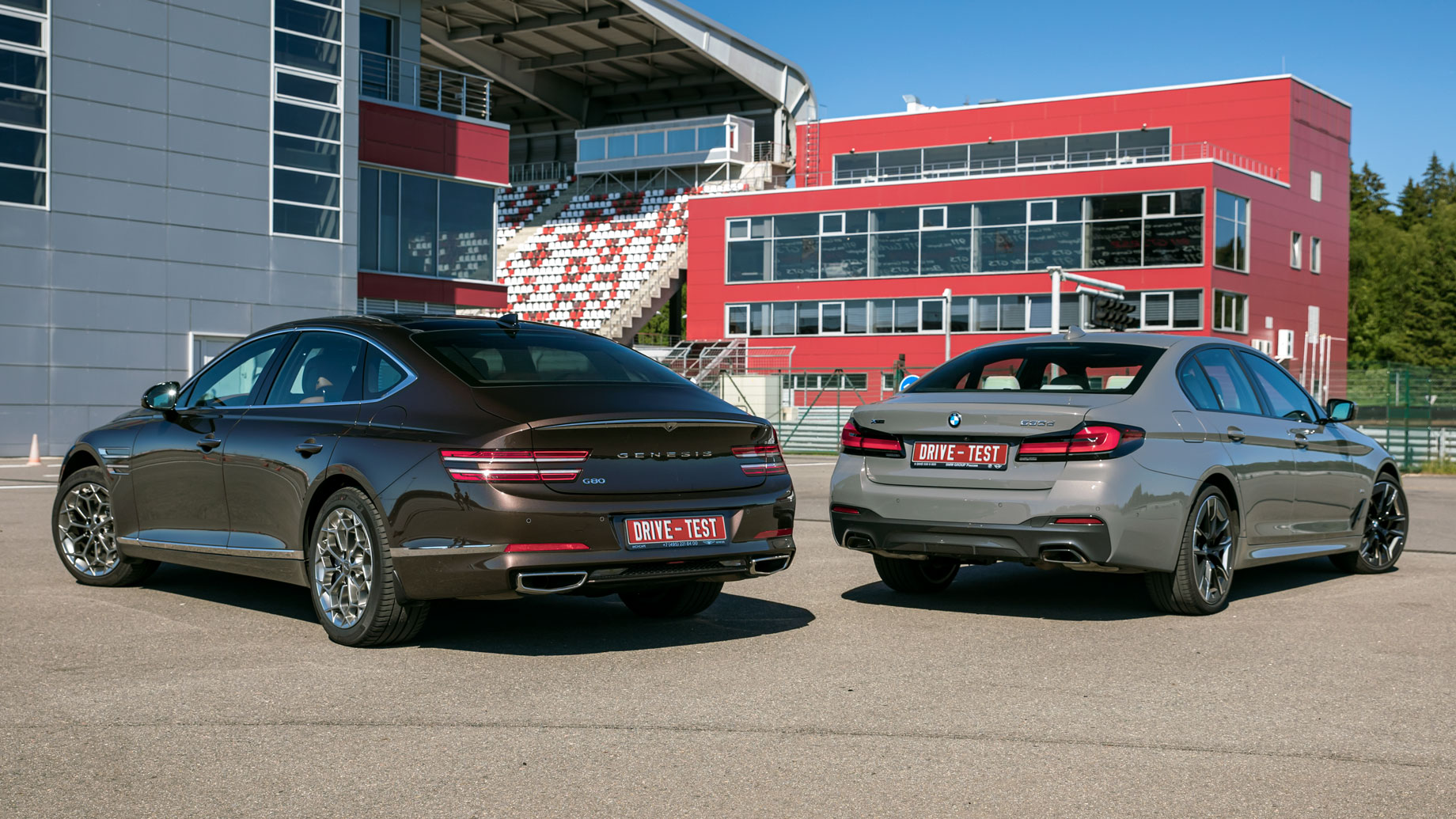
The Genesis G80 is good with the quality of the interior, the hospitality of the second row seats and acoustic comfort, it is at the forefront of the segment. Non-fussy owners will also appreciate the soft operation of the power unit. But Genesis has not only advantages, but also problems: with ergonomics, with steering settings, with suspension work… True, in the case of the G80, the scale of driving flaws is more modest than that of the GV-crossover. Therefore, the sedan is more convenient for the driver, clearer on the steering wheel and more comfortable on the go.
This is a translation. You can read the original here: https://www.drive.ru/test-drive/bmw/genesis/61262bc886232857e05d65f6.html

Published May 19, 2022 • 11m to read

